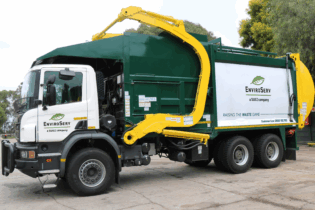After the local PVC industry suffered a huge knock in sales following its bad environmental rap, the Green Building Council of South Africa has officially declared that the use of PVC products in eco-friendly projects will no longer be penalised.
GBCSA gives PVC products the green light Environmentally conscious building contractors in South Africa can now enjoy the full benefits of PVC piping products, following the announcement from the Green Building Council of South Africa (GBCSA) in October 2011 that it will remove the MAT-7 PVC minimisation clause from its Green Star rating system. The GBCSA developed the Green Star SA rating tool to provide the local property industry with an objective measurement for green buildings, and to recognise and reward environmental leadership in the industry. A green building rating tool sets standards and benchmarks for green building and enables an objective assessment to be made as to how ‘green’ a building is. The rating system sets out a menu of all the green measures that can be incorporated into a building in order to make it green. Points are awarded to a building according to which measures have been incorporated and, after appropriate weighting, a total score is arrived at, which determines the rating. The council initially introduced the clause in 2007 to minimise the use of PVC products in buildings, due to environmental concerns regarding the formulation, manufacturing process and end-of-life disposal of PVC products. Following negotiations with the South African Vinyls Association (SAVA), the GBCSA agreed to adopt recommendations to remove the MAT-7 PVC minimisation credit in its rating system, provided that PVC manufacturers adhere to best practice conditions. Initially, a PVC expert reference panel (ERP) was formed, which acted as an advisory group to the GBCSA and assisted with technical matters on domestic and international best environmental practice initiatives related to the manufacture, use and end-of-life of PVC building products. In particular, the panel advised on the applicability of the revised Australian Green Star PVC credit to the South African context. Commitment from SAVA The 24 members of SAVA have committed themselves to the responsible and sustainable use of PVC with the signing of the industry’s Product Stewardship Programme (PSP) at the association’s AGM earlier this year. “Our Product Stewardship Programme is a series of achievable commitments that address the industry’s environmental issues and forms the cornerstones of the association’s focus and activities,” explains Delanie Bezuidenhout, CEO of SAVA. “PVC has, in recent years, received a bad rap from environmentalists, the public and the media who are, in many cases, unaware of the hard work being done behind the scenes to ensure that vinyls are environmentally safe and sustainable.” The association therefore aims to raise awareness of the good qualities of PVC by assisting its members, relevant authorities and experts to understand, characterise and address product stewardship issues associated with the life cycle of PVC products.SAVA is ideally positioned within the local plastics industry and has representation on the Recovery Action Group (RAG), the Packaging Council of South Africa (PACSA) and the Plastics SA Sustainability Council.
Pipe industry welcomes change DPI Plastics product manager for pressure pipe systems Renier Snyman says that the MAT-7 minimisation clause impacted negatively on plastics sales, as contractors and architects would avoid the use of PVC pipes in order to obtain a four or five star green rating for their building. “In the past, any projects that used PVC would be penalised, significantly affecting their rating in an industry that is becoming increasingly environment-conscious,” he explains. GBCSA CEO Brian Wilkinson adds: “In late 2011, the GBCSA completed a comprehensive credit review process for the Mat-7 PVC minimisation credit, which is one out of 69 total credits in the Green Star SA green building rating system. The GBCSA Technical Steering Committee resolved to withdraw the credit after considering the outcomes of the credit review, which involved stakeholder engagement through a PVC Expert Reference Panel and precedents set by other green building councils surrounding the treatment of PVC in green building rating tools.” Snyman points out that the removal of clause now means that the use of PVC products has a neutral impact on the green star rating of a building in South Africa. The neutral rating does, however, only apply to PVC manufacturers that meet best practice based on the manufacture and recycling of the product. Due to its light weight, high strength, low reactivity and corrosion resistance, Snyman notes that PVC is the material best-suited for piping. “PVC has become the most popular piping product in South Africa due to its unique properties. In addition, PVC pipes are almost entirely leak-proof when joined together, making it one of the most reliable piping products in the industry.” Snyman admits that, moving forward, the biggest challenge is to inform and educate the industry of the benefits of the removal of the MAT-7 minimisation clause. “The most effective method of highlighting the benefits of using PVC products in Green Star SA projects will be through word-of-mouth and product displays, in particular to non-residential building projects that are focused on obtaining Green Star SA status.”






